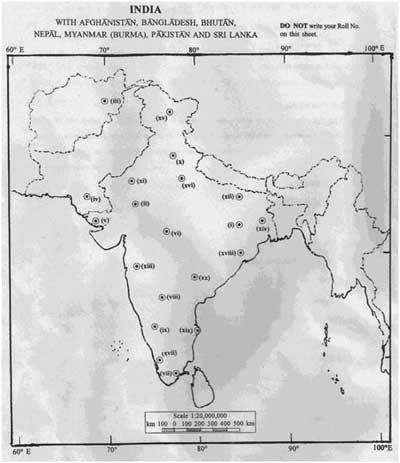(HOT) UPSC Current Affairs 2025 PDF
NEW! The Gist (NOV-2025) | E-BOOKS
(Download) UPSC IAS Mains 2013 : History - Question Paper - 1
(Download) UPSC Mains 2013 : History Paper - I
Question Paper Specific Instructions
Please read each of the following instructions carefully before attempting questions
There are EIGHT questions divided in Two Sections and printed both in HINDI and in ENGLISH.
Candidate has to attempt FIVE questions in all.
Question no. 1 and 5 are compulsory and out of the remaining, THREE are to be attempted choosing at least ONE from each section.
The number of marks carried by a question/part is indicated against it.
Answers must be written in the medium authorized in the Admission certificate which must be stated clearly on the cover of this Question-cum-Answer (QCA) booklet in the space provided. No marks will be given for answers written in medium other than the authorized one.
Word limit in questions, wherever specified, should be adhered to.
Attempts of questions shall be counted in chronological order. Unless struck off, attempt of a question shall be counted even if attempted partly.
Any page or portion of the page left blank in the answer book must be clearly struck off.
Time Allowed: Three Hours Maximum Marks: 250
Q.1 Identify the following places marked on the map into question cum answer booklet supplied to you and right about short notes of 30 words on each of them in the space provided in the booklet. Locational hints for each of the places marked on the map are given below seriatim:
i. A Paleolithic and Mesolithic site
ii. A Mesolithic site
iii. An important halting place
iv. A Pre-Harappan site
v. An important Harappan site
vi. Site of important fossils
vii. A Sea-port
viii. A Paleolithic site
ix. A Neolithic, Megalithic and Chalcolithic site
x. A Harappan site
xi. A Palaeolithic site
xii. A Neolithic site
xiii. A Chalcolithic site
xiv. A Chalcolithic site
xv. A site of Buddhist Monastery
xvi. Painted Grey Ware site
xvii. Site related to a famous Indian Philosopher
xviii. Historical Rock-cut Caves
xix. Famous Fort
xx. Capital of famous Kingdom
Q.2 (a) Evaluate various views regarding human settlements as gleaned from the Vedic sources.
Q.2 (b) Discuss the water management and its conservation planning in the Harappan (Indus-Saraswati) cities.
Q.2 (c) In the absence of a written script Chalcolithic pottery gives us a fascinating insight into the culture and life styles of the people of those times. Comment critically.
Q.3 (a) On the basis of contemporary sources assess the nature of banking and usuary in ancient India.
Q.3 (b) Social norms for women in the Dharmasastra and Arthasastra tradition were framed in accordance with the Varnashrama tradition. Evaluate critically.
Q.3 (c) “The varna concept may always have been largely a theoretical model and never an actual description of society." Comment in the context of Ancient India.
Q.4 (a) Evaluate the contribution of the Puranas in disseminating secular knowledge among the masses in ancient India.
Q.4 (b) Evaluate the ownership of land in ancient India on the basis of literary and epigraphic sources.
Q.4 (c) Explain as to how the early Buddhist Stupa art, while using folk motifs and narratives and common cultural symbols, succeeded in transforming these themes for expounding the Buddhist ideals.
SECTION- B
Q .5 Write short notes in not more than 150 words on each of the following:-
Q.5 (a) Evaluate the Malfuzat texts sources of medieval history.
Q.5 (b) Discuss the state of society and economy of the Bahmani kingdom as gleaned from historical sources.
Q.5 (c) Give a sketch of Indian trade with Europe during the Mughal period.
Q.5 (d) Analyze the steps taken by Razia Sultan to strengthen her position as an independent ruler despite various obstacles.
Q.5 (e) Bhakti and mysticism of Lal Ded emerged as a social force in Kashmir. Comment.
Q.6 (a) Evaluate the conditions of industries in India from 1200 to 1500 CE.
Q.6 (b) On the basis of contemporary sources evaluate the system of agriculture and irrigation of the Vijaynagar kingdom.
Q.6 (c) Critically evaluate the educational development during Sultanate period.
Q.7 (a) On the basis of the accounts of Europeans being out the agrarian crisis of the 17th century CE India.
Q.7 (b) Evaluate critically the conditions of labour from 1200 - 1500 CE on the basis of historical sources.
Q.7 (c) Discuss and evaluate critically various trends in the historiography of bhakti.
Q.8 (a) Analyze how the political processes of state formation of Mewar, from 10th-15th century CE was challenged in the 16th century CE by the imperialist policy of Akbar.
Q.8 (b) Assess the Lekhapaddhati as an important source for evaluating the society and economy of the thirteenth century CE with special reference to Gujarat.
Q.8 (c) Assess the development of Science and Technology in the Mughal period.
Subject: History Paper - I
File Size: 1.34 MB
File Type: Zipped PDF



